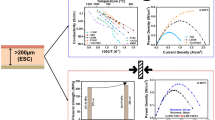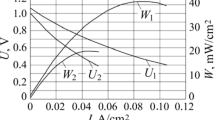Abstract
A technique for formation of electrolyte thin films with the thickness of 6–10 μm of zirconia stabilized by yttria (YSZ) is developed on the basis of the method of chemical deposition from the vapor phase of organometallic compounds (MOCVD). Planar electrochemical cells based on film electrolyte with a supporting anode with the working surface area of 12 cm2 were manufactured. A solid-oxide fuel cell (SOFC) based on two fuel cells was developed and its life cycle tests at reduced operating temperatures (<800°C) were carried out for 400 h. The maximum power density reached in the SOFC tests was 316 mW/cm2.
Similar content being viewed by others
References
Larminie, J. and Dicks, A., Fuel Cell Systems Explained, West Sussex, England: Welly, 2002, p. 166.
Will, J., Mitterdorfer, A., Kleinlogel, C., Perednis, D., and Gauckler, L.J., Solid State Ionics, 2000, vol. 131, p. 79.
De Souza, S., Visco, S.J., and de Jonghe, L.C., Solid State Ionics, 1997, vol. 98, p. 57.
Kobayashi, K., Takahashi, I., Shiono, M., and Dokiya, M., Solid State Ionics, 2002, vol. 152–153, p. 591.
Jung Hwa Young, Hong Kug-Sun, Jung Hun-Gi, Kim Hyoungchul, Kim Hae-Ryoung, Son Ji-Won, Kim Joosun, Lee Hae-Weon, Lee Jong-Ho, J. Electrochem. Soc., 2007, vol. 154(5), p. B480.
Yamane, H. and Hirai, T., J. Mater. Sci. Lett., 1987, vol. 6, p. 1229.
Schiller, G., Henne, R., Lang, M., Ruckdaschel, R., Schöper S., Proc. Fourth European Solid Oxide Fuel Cell Forum, Lucerne, Switzerland, 2000, vol. 1, p. 37.
Bobrenok, O.F. and Predtechenskii, M.R., Elektrokhimiya, 2009, vol. 45, p 616 [Russ. J. Electrochem., 2009, vol. 45, p.580].
Gel’fond, N.V., Bobrenok, O.F., Predtechenskii, M.R., Morozova, N.B., Zherikova, K.V., and Igumenov, I.K., Neorgan. Mater., 2009, vol. 45, p. 718.
Author information
Authors and Affiliations
Corresponding author
Additional information
Original Russian Text © O.F. Bobryonok, M.R. Predtechenskii, 2011, published in Elektrokhimiya, 2011, Vol. 47, No. 4, pp. 511–516.
Rights and permissions
About this article
Cite this article
Bobryonok, O.F., Predtechenskii, M.R. Development of solid–oxide fuel cell for reduced operating temperatures. Russ J Electrochem 47, 482–487 (2011). https://doi.org/10.1134/S1023193511040045
Received:
Published:
Issue Date:
DOI: https://doi.org/10.1134/S1023193511040045




